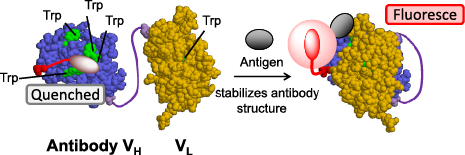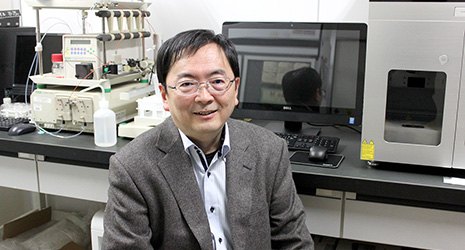Home > Highlighting JAPAN > Highlighting Japan January 2017 > Science & Technology
Highlighting JAPAN


Throwing Light on Drugs and Pathogens
Professor Hiroshi Ueda and his research group have discovered a technology for the quick and simple detection of illicit drugs.
The main research focus of Professor Hiroshi Ueda’s laboratory at Tokyo Institute of Technology is protein engineering. Protein engineering is the scientific discipline that deals with technology for changing natural proteins to create distinctly new proteins. Proteins play a crucial role in the activities of life forms, as enzymes, immune antibodies, and substances that transfer information in living organisms, and protein engineering aims to effectively utilize such specific functions of proteins in a wide range of areas including pharmaceutical drugs, the environment, and public safety and security.
Professor Ueda explains, “Just as engineers use iron and plastic to make machines, our research is about how to make machines using proteins.”
The application of protein engineering led to Professor Ueda and his research group developing the Q-body Method in 2011, which can detect illicit drugs such as stimulants, cocaine, and morphine. Existing detection methods took at least 40 minutes, but with the Q-body Method drugs can be detected in just a few seconds. Moreover, with the Q-body Method, simply mixing a minuscule amount of detection sample with the measuring reagent makes it possible to accurately identify the drug. Given these advantages, the method shows great promise with regards to its application to drug testing by the police or simple screening by customs to prevent the influx of illicit drugs from overseas at the borders.
Our bodies have an immune system called an antigen-antibody reaction. The antigen-antibody reaction is a reaction in which antibodies that are proteins recognize and combine antigens such as pathogenic microorganisms, thereby eliminating the pathogens. The Q-body Method is one type of immunoassay method that utilizes this antigen-antibody reaction. Immunoassay methods have been receiving attention in recent years as a superior measurement method in testing and diagnostics, since they are able to detect various substances with high sensitivity and precision, and have a wide scope of application. The scope of application encompasses public safety and security, such as criminal case investigation, defense, and counterterrorism measures; healthcare, including influenza and cancer diagnosis; and environment, such as water quality and atmosphere surveys, residual pesticides, and food allergen testing.
However, typical existing immunoassay methods have significant problems: they require specialist knowledge, so cannot be easily administered by the general public; measuring is time-consuming and laborious, making them costly; the measuring reagent potentially contained environmental pollutants; and changes in the reagent are confirmed visually, so there is a danger of making an erroneous judgment.
The Q-body Method is a revolutionary immunoassay method that offers a fundamental solution to these challenges. The key to the Q-body Method is proteins called quenchbodies developed by Professor Ueda and his research group. When the quenchbody used as the reagent comes into contact with specific antigens such as drugs or pathogens, it causes an antigen-antibody reaction and the structure changes immediately so that it emits fluorescence. This is measured using a portable detection device equipped with a sensor to detect the strength of the fluorescence, thus determining whether or not the reagent contains the target substance. It is also possible to determine the presence or absence of illicit drugs by checking a person’s urine or saliva.
“If several nanograms (one nanogram is one billionth of a gram) of the substance you want to check for is present, it can detect it. All that’s needed to arrive at a measurement is to mix it with a minuscule amount of the sample and measure the strength of the fluorescence,” says Professor Ueda. “An objective judgment can be made by anyone, without the need for specialist knowledge. Also, the device is compact, so measurements can be taken wherever needed.”
In order to detect a certain type of substance, the Q-body Method requires a dedicated reagent that responds to that substance. Therefore, the range of quenchbodies to use as reagents becomes key. Currently, in addition to that for illicit drugs mentioned above, a total of twenty types of quenchbodies have been completed, including those for the influenza virus, mold toxins, and neonicotinoid pesticides.
“We are currently making quenchbodies using gene manipulation, which is time-consuming and laborious,” says Professor Ueda. “As one way of resolving this, we are also trying out a method of creating quenchbodies by chemically treating the proteins present in our blood, for example. If this method is successful, it promises to dramatically increase the speed at which we develop various kinds of quenchbodies.”
A prototype detection device for illegal drugs has already been completed in 2016 by a manufacturer that has been engaged in joint development with the laboratory.
Currently, the laboratory is conducting verification testing with the aim of commercializing the device.
In the future, the day may come when practical application of the Q-body Method produces a mask that detects the influenza virus, for example.
© 2009 Cabinet Office, Government of Japan






